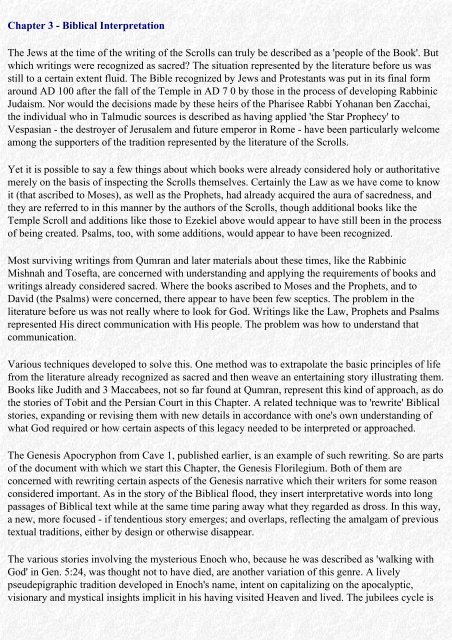Dead Sea Scrolls Uncovered - The Preterist Archive
Dead Sea Scrolls Uncovered - The Preterist Archive
Dead Sea Scrolls Uncovered - The Preterist Archive
You also want an ePaper? Increase the reach of your titles
YUMPU automatically turns print PDFs into web optimized ePapers that Google loves.
Chapter 3 - Biblical Interpretation<br />
<strong>The</strong> Jews at the time of the writing of the <strong>Scrolls</strong> can truly be described as a 'people of the Book'. But<br />
which writings were recognized as sacred? <strong>The</strong> situation represented by the literature before us was<br />
still to a certain extent fluid. <strong>The</strong> Bible recognized by Jews and Protestants was put in its final form<br />
around AD 100 after the fall of the Temple in AD 7 0 by those in the process of developing Rabbinic<br />
Judaism. Nor would the decisions made by these heirs of the Pharisee Rabbi Yohanan ben Zacchai,<br />
the individual who in Talmudic sources is described as having applied 'the Star Prophecy' to<br />
Vespasian - the destroyer of Jerusalem and future emperor in Rome - have been particularly welcome<br />
among the supporters of the tradition represented by the literature of the <strong>Scrolls</strong>.<br />
Yet it is possible to say a few things about which books were already considered holy or authoritative<br />
merely on the basis of inspecting the <strong>Scrolls</strong> themselves. Certainly the Law as we have come to know<br />
it (that ascribed to Moses), as well as the Prophets, had already acquired the aura of sacredness, and<br />
they are referred to in this manner by the authors of the <strong>Scrolls</strong>, though additional books like the<br />
Temple Scroll and additions like those to Ezekiel above would appear to have still been in the process<br />
of being created. Psalms, too, with some additions, would appear to have been recognized.<br />
Most surviving writings from Qumran and later materials about these times, like the Rabbinic<br />
Mishnah and Tosefta, are concerned with understanding and applying the requirements of books and<br />
writings already considered sacred. Where the books ascribed to Moses and the Prophets, and to<br />
David (the Psalms) were concerned, there appear to have been few sceptics. <strong>The</strong> problem in the<br />
literature before us was not really where to look for God. Writings like the Law, Prophets and Psalms<br />
represented His direct communication with His people. <strong>The</strong> problem was how to understand that<br />
communication.<br />
Various techniques developed to solve this. One method was to extrapolate the basic principles of life<br />
from the literature already recognized as sacred and then weave an entertaining story illustrating them.<br />
Books like Judith and 3 Maccabees, not so far found at Qumran, represent this kind of approach, as do<br />
the stories of Tobit and the Persian Court in this Chapter. A related technique was to 'rewrite' Biblical<br />
stories, expanding or revising them with new details in accordance with one's own understanding of<br />
what God required or how certain aspects of this legacy needed to be interpreted or approached.<br />
<strong>The</strong> Genesis Apocryphon from Cave 1, published earlier, is an example of such rewriting. So are parts<br />
of the document with which we start this Chapter, the Genesis Florilegium. Both of them are<br />
concerned with rewriting certain aspects of the Genesis narrative which their writers for some reason<br />
considered important. As in the story of the Biblical flood, they insert interpretative words into long<br />
passages of Biblical text while at the same time paring away what they regarded as dross. In this way,<br />
a new, more focused - if tendentious story emerges; and overlaps, reflecting the amalgam of previous<br />
textual traditions, either by design or otherwise disappear.<br />
<strong>The</strong> various stories involving the mysterious Enoch who, because he was described as 'walking with<br />
God' in Gen. 5:24, was thought not to have died, are another variation of this genre. A lively<br />
pseudepigraphic tradition developed in Enoch's name, intent on capitalizing on the apocalyptic,<br />
visionary and mystical insights implicit in his having visited Heaven and lived. <strong>The</strong> jubilees cycle is

















